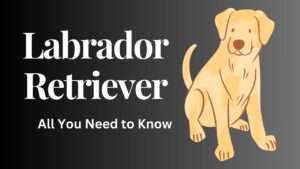In the heart of Alaska’s icy wilderness, there exists a majestic breed that embodies strength, loyalty, and adventure: the Alaskan Malamute. Picture a creature bred to brave the harshest climates, with a spirit as wild as the landscape it calls home. Are you ready to delve into the world of this magnificent Arctic companion?
Contents Overview
Breed Overview: Alaskan Malamute
Size: The Alaskan Malamute stands as a testament to canine grandeur, boasting a sturdy and powerful build. Males typically range between 25 to 28 inches (63.5 to 71 cm) in height at the shoulder, while females measure slightly smaller, at 23 to 26 inches (58.5 to 66 cm). In terms of weight, these magnificent creatures tip the scales between 75 to 85 pounds (34 to 39 kg) for females, and 85 to 100 pounds (39 to 45 kg) for males.
Appearance: Imagine a canine adorned with a thick, double-layered coat designed to repel the biting cold of the Arctic. The Alaskan Malamute’s fur comes in various shades, including gray, black, sable, and red, often accompanied by striking facial masks. Their wolf-like appearance, accentuated by erect ears and a plumed tail, evokes an aura of primal beauty.
Life Span: Step into a world where companionship knows no bounds, as the Alaskan Malamute blesses households with its presence for an average lifespan of 10 to 14 years. With proper care, nutrition, and exercise, these resilient creatures grace their families with years of love, loyalty, and boundless adventures.
History and Origins of the Alaskan Malamute
In the frozen expanse of Alaska’s rugged terrain, the Alaskan Malamute emerges as a living testament to centuries-old heritage and resilience. Let’s embark on a journey through time to uncover the rich tapestry of this majestic breed’s history.
Origins:
- Ancient Roots: The Alaskan Malamute traces its lineage back thousands of years to the indigenous Mahlemut people of western Alaska, who relied on these canines for transportation and survival in the unforgiving Arctic landscape.
- Utility and Companionship: Revered as indispensable partners in hunting expeditions and sled-pulling endeavors, Malamutes served as loyal companions, offering warmth and protection to their human counterparts amidst the harsh elements.
Exploration and Development:
- Gold Rush Era: With the onset of the Klondike Gold Rush in the late 19th century, the demand for robust sled dogs skyrocketed, propelling the Alaskan Malamute into the spotlight as an invaluable asset for transportation and freight hauling.
- Selective Breeding: Through meticulous selection and breeding practices, the Malamute’s physical attributes and endurance were honed to perfection, ensuring optimal performance in arduous Arctic conditions.
Recognition and Conservation:
- American Kennel Club (AKC): The Alaskan Malamute was officially recognized by the American Kennel Club in 1935, cementing its status as a distinct and cherished breed within the canine community.
- Conservation Efforts: Despite facing challenges from modernization and the decline of traditional sled dog culture, dedicated enthusiasts and breeders remain steadfast in preserving the Alaskan Malamute’s genetic integrity and historical legacy.
Legacy and Cultural Significance:
- Symbol of Strength: Revered for their strength, endurance, and unwavering loyalty, Alaskan Malamutes have transcended their role as mere working dogs to become enduring symbols of fortitude and companionship.
- Pop Culture Icon: From literature to film, the Alaskan Malamute has left an indelible mark on popular culture, captivating audiences with its noble bearing and untamed spirit.
As we reflect on the storied past of the Alaskan Malamute, we are reminded of the profound bond between humans and animals, forged through shared adversity and mutual respect. In the next section, let’s delve deeper into the distinctive characteristics and temperament of this remarkable breed.
Temperament and Personality of the Alaskan Malamute
In the realm of canine companionship, the Alaskan Malamute stands as a paragon of loyalty, intelligence, and indomitable spirit. Let’s unravel the layers of this breed’s temperament and delve into the captivating world of their personality.
- Affectionate and Loyal:
- Bonding with Family: Alaskan Malamutes form deep bonds with their human families, showering them with affection and unwavering loyalty. They thrive on companionship and seek to be an integral part of daily activities.
- Protective Instincts: With a keen sense of loyalty, Malamutes exhibit a natural protectiveness towards their loved ones, making them vigilant guardians of their home and hearth.
- Playful and Energetic:
- Endless Energy: True to their working dog heritage, Alaskan Malamutes possess boundless energy and enthusiasm for outdoor activities. Whether it’s hiking through rugged terrain or frolicking in the snow, they relish every opportunity for adventure.
- Playful Demeanor: Despite their imposing size, Malamutes retain a playful and mischievous streak, often engaging in games and antics that showcase their joyful disposition.
- Independent Thinkers:
- Strong-Willed Nature: Alaskan Malamutes boast a streak of independence and intelligence, which can sometimes manifest as stubbornness. They prefer to march to the beat of their own drum and may require patient, consistent training to channel their strong-willed nature effectively.
- Problem-Solving Skills: Blessed with sharp intellect, Malamutes excel at problem-solving tasks and enjoy mental stimulation through interactive games and challenges.
- Sociable and Gentle:
- Friendly Demeanor: Despite their imposing appearance, Alaskan Malamutes possess a gentle and amiable disposition towards both humans and other animals. They thrive in social settings and relish the company of friends, both furry and otherwise.
- Child-Friendly: Known for their patience and gentle demeanor, Malamutes often form strong bonds with children, making them cherished playmates and protectors.
- Vocal Communicators:
- Distinctive Vocalizations: Alaskan Malamutes are renowned for their repertoire of vocalizations, which range from melodious howls to expressive barks and grumbles. They use their vocal prowess to communicate a wide array of emotions, from excitement to apprehension.
- Need for Stimulation:
- Mental and Physical Exercise: To thrive, Alaskan Malamutes require ample mental and physical stimulation. Engaging in regular exercise, interactive play, and training sessions not only keeps them physically fit but also helps channel their energy constructively.
In essence, the Alaskan Malamute embodies a harmonious blend of strength, affection, and intelligence, making them cherished companions for those who appreciate the beauty of a true Arctic spirit. But before inviting one of these majestic creatures into your home, it’s essential to understand their unique needs and commit to providing the love, care, and guidance they deserve.
Exercise and Training Needs of the Alaskan Malamute
Unlocking the full potential of an Alaskan Malamute entails understanding and fulfilling their distinct exercise and training requirements. Let’s explore how to keep these magnificent canines physically and mentally stimulated for optimal well-being.
- Daily Exercise Regimen:
- Long Walks and Hikes: Alaskan Malamutes thrive on vigorous exercise and require a minimum of one to two hours of physical activity each day. Long walks, hikes, or runs provide opportunities for them to expend energy and explore their surroundings.
- Sled Pulling and Weight Pulling: Given their heritage as sled dogs, Malamutes excel in activities like sled pulling or weight pulling. Engaging in these tasks not only fulfills their natural instincts but also strengthens their muscles and boosts their endurance.
- Mental Stimulation:
- Interactive Toys and Games: Keep your Malamute mentally sharp by incorporating interactive toys and games into their routine. Puzzle feeders, treat-dispensing toys, and obedience training sessions provide mental challenges that satisfy their intellectual curiosity.
- Variety in Activities: Rotate through a variety of activities to prevent boredom and keep your Malamute engaged. Consider agility training, scent work, or obedience trials to stimulate their mind and foster a deeper bond with your furry companion.
- Consistent Training Approach:
- Positive Reinforcement: Malamutes respond best to positive reinforcement training methods, which involve rewarding good behavior with treats, praise, or playtime. Use gentle, consistent guidance to establish clear boundaries and reinforce desired behaviors.
- Early Socialization: Start socializing your Malamute from a young age to acclimate them to different people, animals, and environments. Exposing them to various stimuli helps prevent behavioral issues and fosters a well-rounded, confident dog.
- Leadership and Structure:
- Establishing Leadership: Malamutes thrive in environments with clear leadership and structure. Be a calm, confident leader who sets consistent rules and boundaries, earning their respect and trust through fair and patient guidance.
- Routine and Predictability: Maintain a consistent daily routine to provide your Malamute with a sense of stability and security. Regular meal times, exercise sessions, and training activities create predictability, reducing stress and anxiety.
- Supervised Playtime:
- Safe Play Environments: When engaging in off-leash play or outdoor activities, ensure the environment is secure and free from hazards. Malamutes have a tendency to explore and may wander if not properly supervised.
- Interaction with Other Dogs: Monitor interactions with other dogs, especially smaller breeds, due to the Malamute’s strong prey drive and potential for rough play. Supervised introductions and controlled socialization sessions can help foster positive relationships with canine companions.
- Adaptation to Climate:
- Consideration of Weather Conditions: While Malamutes are well-adapted to cold climates, they can overheat in hot weather. Provide ample shade, fresh water, and indoor cooling options during warmer months to prevent heat-related illnesses.
By incorporating a balanced regimen of physical exercise, mental stimulation, and consistent training, you can cultivate a harmonious relationship with your Alaskan Malamute while nurturing their natural instincts and abilities. With patience, dedication, and a dash of Arctic spirit, you’ll embark on a rewarding journey filled with adventure and companionship.
Alaskan Malamute’s Coat: Type and Length
Draped in a luxuriant mantle that whispers of Arctic origins, the Alaskan Malamute’s coat serves as both a shield against the elements and a testament to their heritage. Let’s explore the distinctive characteristics of their fur, from its type to its majestic length.
- Double Coat Structure:
- Undercoat: At the heart of the Malamute’s coat lies a dense, insulating undercoat designed to trap heat and repel moisture in frigid temperatures. This soft underlayer provides essential warmth during harsh winter conditions.
- Guard Hairs: Overlaying the undercoat are longer, coarser guard hairs that form a protective barrier against wind, snow, and debris. These outer hairs help shed water and maintain the integrity of the undercoat.
- Thick and Weather-Resistant:
- Insulating Properties: The Alaskan Malamute’s double-layered coat boasts exceptional insulating properties, keeping them snug and cozy even in sub-zero temperatures. This thick fur acts as a natural barrier against frostbite and hypothermia, enabling them to thrive in Arctic climates.
- Water-Repellent: Thanks to the water-resistant qualities of their guard hairs, Malamutes can navigate through snow and ice with ease, shaking off moisture to stay dry and comfortable during outdoor adventures.
- Length and Texture:
- Medium-Length Fur: Alaskan Malamutes sport a medium-length fur coat that provides ample coverage without hindering mobility. The length varies slightly across different regions of the body, with longer fur around the neck, shoulders, and tail.
- Coarse and Dense Texture: Their fur exhibits a coarse, dense texture, which helps withstand the rigors of their outdoor lifestyle. Despite its rugged appearance, the Malamute’s fur is surprisingly soft to the touch, inviting cuddles and affectionate strokes.
- Seasonal Shedding Cycle:
- Biannual Shedding: Twice a year, typically during the spring and fall seasons, Alaskan Malamutes undergo a significant shedding process known as “blowing their coat.” During this time, they shed their undercoat to prepare for the changing temperatures, requiring regular grooming to manage the shedding.
- Year-Round Maintenance: While shedding may intensify during seasonal transitions, Malamutes benefit from year-round grooming to prevent matting, remove loose fur, and maintain overall coat health. Regular brushing helps distribute natural oils, keeping their fur soft and lustrous.
- Coat Colors and Markings:
- Variety of Shades: Alaskan Malamutes come in a range of coat colors, including shades of gray, black, sable, and red. Some individuals may exhibit a combination of colors, often accompanied by striking facial masks and distinctive markings.
- Unique Markings: Facial markings, such as masks or blaze patterns, add to the allure of the Malamute’s appearance, accentuating their expressive eyes and noble visage.
The Alaskan Malamute’s coat serves as a testament to their resilience, providing both protection from the elements and a canvas for their distinctive beauty. As stewards of these magnificent creatures, it’s essential to nurture and maintain their coat with care, honoring their Arctic heritage with each gentle brushstroke.
Grooming and Care for Your Alaskan Malamute
Caring for an Alaskan Malamute involves more than just providing food and shelter; it’s about nurturing their unique coat and meeting their specific grooming needs. Let’s delve into the essential aspects of grooming and care to ensure your Malamute remains healthy, comfortable, and radiant.
- Brushing Routine:
- Regular Brushing: Due to their dense double coat, Alaskan Malamutes benefit from frequent brushing to prevent matting and remove loose fur. Aim for brushing sessions at least 2-3 times per week, increasing frequency during seasonal shedding periods.
- Use of Proper Tools: Invest in high-quality grooming tools, such as an undercoat rake or slicker brush, to effectively remove dead hair and distribute natural oils throughout the coat. A deshedding tool can also help manage shedding and reduce the formation of mats.
- Bathing Guidelines:
- Occasional Baths: Alaskan Malamutes have a self-cleaning coat and typically require baths only when visibly dirty or after outdoor adventures. Use a mild dog shampoo formulated for sensitive skin to avoid stripping their coat of essential oils.
- Thorough Rinsing: Ensure thorough rinsing to remove all traces of shampoo, as leftover residue can irritate the skin and lead to dryness or itchiness. Pay special attention to areas prone to trapping debris, such as the underbelly and paw pads.
- Nail Care:
- Regular Trimming: Keep your Malamute’s nails trimmed to a comfortable length, as overgrown nails can cause discomfort and affect their gait. Trim nails every 4-6 weeks or as needed, taking care to avoid cutting into the quick, which can cause bleeding and pain.
- Gentle Handling: Use sharp, canine-specific nail clippers and approach nail trimming with patience and care. If your Malamute is uncomfortable with nail trimming, gradually acclimate them to the process through positive reinforcement and rewards.
- Dental Hygiene:
- Daily Brushing: Maintain your Malamute’s oral health by brushing their teeth daily with a dog-friendly toothpaste and toothbrush. Regular brushing helps prevent plaque buildup, tartar formation, and gum disease, promoting overall dental hygiene.
- Dental Chews and Toys: Supplement regular brushing with dental chews or toys designed to promote chewing and reduce plaque accumulation. Choose products approved by veterinarians and monitor your Malamute during chewing sessions to prevent ingestion of large pieces.
- Ear Cleaning:
- Weekly Inspection: Check your Malamute’s ears weekly for signs of redness, irritation, or wax buildup. Gently lift the ear flap and inspect the inner ear for any abnormalities or foul odors, which may indicate an infection.
- Gentle Cleaning: Cleanse the ear with a veterinarian-recommended ear cleaning solution and cotton balls or pads. Avoid using cotton swabs or inserting anything into the ear canal, as this can cause injury or push debris further into the ear.
- Environmental Considerations:
- Temperature Regulation: Ensure your Malamute has access to shade and fresh water during hot weather to prevent overheating. In colder climates, provide shelter from harsh winds and freezing temperatures, along with extra bedding for warmth.
- Tick and Flea Prevention: Protect your Malamute from parasites by using veterinarian-approved tick and flea prevention products. Regularly inspect their coat for signs of ticks or fleas, especially after outdoor excursions in wooded or grassy areas.
- Professional Grooming:
- Regular Vet Visits: Schedule routine veterinary check-ups to monitor your Malamute’s overall health and address any grooming-related concerns, such as skin issues or dental problems. Your veterinarian can provide guidance on grooming techniques and recommend professional groomers if needed.
- Professional Grooming Sessions: Consider occasional visits to a professional groomer for services such as coat trimming, nail clipping, and ear cleaning. Professional groomers have the expertise and tools to ensure your Malamute receives top-notch grooming care.
By integrating these grooming and care practices into your routine, you’ll not only maintain your Alaskan Malamute’s physical well-being but also strengthen the bond between you and your furry companion. With patience, consistency, and a gentle touch, you’ll embark on a journey of mutual care and companionship that lasts a lifetime.
Shedding Level of the Alaskan Malamute
Prepare to embrace the beauty of the shedding season with your Alaskan Malamute, as their fur undergoes a biannual transformation that can rival even the most dramatic of natural phenomena. Let’s explore the shedding level of the Alaskan Malamute and how to manage their seasonal fur loss with grace and ease.
- Biannual Shedding Cycle:
- Blowing Their Coat: Twice a year, typically during the spring and fall seasons, Alaskan Malamutes experience a significant shedding event known colloquially as “blowing their coat.” During this time, they shed their thick undercoat to accommodate the changing temperatures and daylight hours.
- Intense Shedding: Shedding during the blowing coat phase can be particularly intense, with tufts of fur seemingly appearing out of thin air. Be prepared for a flurry of fur throughout your home as your Malamute releases their winter insulation in preparation for warmer weather.
- Year-Round Maintenance:
- Regular Grooming: While shedding may peak during seasonal transitions, Alaskan Malamutes benefit from year-round grooming to manage their coat and minimize shedding. Regular brushing helps remove loose fur, prevent matting, and distribute natural oils, promoting overall coat health.
- Consistent Maintenance: Establish a grooming routine that includes brushing sessions at least 2-3 times per week, with increased frequency during shedding seasons. Use grooming tools designed to penetrate the dense undercoat and capture loose fur effectively.
- Managing Shedding Indoors:
- Strategic Cleaning: Embrace the art of strategic cleaning to minimize the impact of shedding on your home environment. Invest in quality vacuum cleaners and lint rollers to swiftly remove fur from floors, furniture, and clothing.
- Washable Covers: Consider using washable covers on furniture and bedding to protect them from fur accumulation. These covers can be easily removed and laundered as needed, keeping your living spaces fresh and fur-free.
- Outdoor Maintenance:
- Regular Outdoor Brushing: Take advantage of outdoor grooming sessions to minimize fur buildup indoors. Brush your Malamute outside to allow loose fur to drift away with the breeze, reducing the need for extensive indoor cleanup.
- Mindful Shedding Zones: Designate specific outdoor shedding zones where your Malamute can release excess fur without causing inconvenience. This could be a designated grooming area or a secluded spot in the yard away from high-traffic areas.
- Nutrition and Hydration:
- Quality Diet: Ensure your Malamute receives a balanced diet rich in essential nutrients, including omega-3 fatty acids, which support healthy skin and coat. Consult with your veterinarian to select a high-quality dog food tailored to your Malamute’s specific needs.
- Hydration: Encourage adequate hydration to maintain skin health and support the shedding process. Provide fresh, clean water at all times, especially during shedding seasons when increased water intake may be beneficial.
- Professional Assistance:
- Veterinary Guidance: Seek guidance from your veterinarian if you notice excessive shedding or changes in your Malamute’s coat quality, as these may indicate underlying health issues. Your veterinarian can perform diagnostic tests and recommend appropriate treatment options.
- Professional Grooming Services: Consider enlisting the help of professional groomers for deep grooming sessions or coat maintenance during shedding seasons. Professional groomers have the expertise and tools to manage shedding effectively and ensure your Malamute’s coat remains healthy and vibrant.
While the shedding level of the Alaskan Malamute may seem daunting at times, with proper grooming techniques and a touch of patience, you can navigate the shedding season with confidence and grace. Embrace the natural beauty of your Malamute’s coat as they undergo their biannual transformation, knowing that a little fur is a small price to pay for the unconditional love and companionship they provide.
Common Health Issues in Alaskan Malamutes
While Alaskan Malamutes are known for their robust health and resilience, like all breeds, they may be prone to certain genetic predispositions and health concerns. Understanding these common health issues can help you stay vigilant and proactive in maintaining your Malamute’s well-being. Let’s explore some of the conditions commonly observed in Alaskan Malamutes:
- Hip Dysplasia:
- Description: Hip dysplasia is a hereditary condition where the hip joint doesn’t develop properly, leading to malformation and eventual degeneration of the joint.
- Symptoms: Signs of hip dysplasia may include lameness, reluctance to exercise, difficulty rising, and decreased range of motion in the hind limbs.
- Management: Treatment options range from medication and weight management to surgical interventions such as total hip replacement or femoral head ostectomy.
- Elbow Dysplasia:
- Description: Elbow dysplasia is a developmental condition affecting the elbow joint, characterized by abnormal growth or formation of the joint structures.
- Symptoms: Common symptoms include intermittent or persistent lameness in the front limbs, stiffness, and reluctance to engage in physical activity.
- Management: Treatment may involve pain management, physical therapy, and in severe cases, surgical correction to address the underlying joint abnormalities.
- Progressive Retinal Atrophy (PRA):
- Description: Progressive retinal atrophy is a group of genetic eye diseases that cause degeneration of the retina, eventually leading to blindness.
- Symptoms: Early signs may include night blindness, dilated pupils, and an increased tendency to bump into objects or become disoriented in dim lighting.
- Management: While there is no cure for PRA, supportive care and environmental modifications can help improve your Malamute’s quality of life. Regular veterinary check-ups and ophthalmologic evaluations are essential for monitoring disease progression.
- Chondrodysplasia (Dwarfism):
- Description: Chondrodysplasia, also known as dwarfism, is a genetic condition characterized by abnormal skeletal growth, resulting in disproportionately short limbs.
- Symptoms: Affected Malamutes may exhibit short stature, bowed limbs, and reduced mobility due to skeletal deformities.
- Management: Management focuses on supportive care and addressing associated orthopedic issues. Breeders should screen for chondrodysplasia to prevent passing on the gene responsible for the condition.
- Gastric Dilatation-Volvulus (GDV):
- Description: GDV, commonly known as bloat, is a life-threatening condition characterized by the rapid distention and twisting of the stomach.
- Symptoms: Symptoms may include restlessness, unproductive attempts to vomit, abdominal distention, and signs of shock such as pale gums and rapid heartbeat.
- Management: Immediate veterinary intervention is crucial to stabilize the patient and alleviate gastric torsion. Treatment typically involves decompression of the stomach, fluid therapy, and surgical correction to prevent recurrence.
- Hypothyroidism:
- Description: Hypothyroidism occurs when the thyroid gland fails to produce sufficient thyroid hormone, leading to metabolic imbalances.
- Symptoms: Common signs of hypothyroidism in Malamutes include lethargy, weight gain, hair loss, skin infections, and cold intolerance.
- Management: Treatment involves lifelong thyroid hormone replacement therapy to restore hormonal balance and alleviate clinical signs.
- Osteochondritis Dissecans (OCD):
- Description: OCD is a developmental orthopedic condition characterized by the abnormal growth or detachment of cartilage within the joints, most commonly affecting the shoulder or elbow.
- Symptoms: Symptoms may include intermittent or persistent lameness, joint swelling, and reluctance to bear weight on the affected limb.
- Management: Treatment options range from conservative management with rest and anti-inflammatory medications to surgical intervention, such as arthroscopy or cartilage grafting, to address the underlying joint abnormalities.
- Cancer:
- Description: Like many large breeds, Alaskan Malamutes may be predisposed to certain types of cancer, including hemangiosarcoma, osteosarcoma, and lymphoma.
- Symptoms: Clinical signs vary depending on the type and location of the cancer but may include lumps or masses, unexplained weight loss, lethargy, and changes in appetite or behavior.
- Management: Treatment options for cancer in Malamutes may include surgery, chemotherapy, radiation therapy, and palliative care to manage symptoms and improve quality of life.
Preventive Measures and Care Tips:
- Regular Veterinary Check-ups: Schedule routine veterinary examinations to monitor your Malamute’s health and address any emerging concerns promptly.
- Genetic Screening: Work with reputable breeders who conduct health screenings and genetic testing to reduce the risk of hereditary diseases in puppies.
- Nutrition and Exercise: Provide a balanced diet, regular exercise, and weight management to support your Malamute’s overall health and well-being.
- Environmental Enrichment: Stimulate your Malamute’s mind and body with interactive toys, mental challenges, and opportunities for socialization and physical activity.
- Dental Care: Maintain good oral hygiene through regular tooth brushing and dental check-ups to prevent periodontal disease and related health issues.
By staying informed about potential health concerns and implementing preventive measures, you can help ensure a long, happy, and healthy life for your Alaskan Malamute companion. Regular veterinary care, responsible breeding practices, and attentive management are key to promoting optimal health and well-being in this magnificent breed.
Drooling Level of the Alaskan Malamute
Prepare to welcome a majestic companion into your life without the worry of excessive drool, as the Alaskan Malamute typically maintains a moderate to low drooling level. Let’s explore the factors influencing drooling in Malamutes and how to manage any occasional drool with ease.
- Breed Characteristics:
- Moderate Drooling Tendency: Alaskan Malamutes are not known for excessive drooling compared to some other breeds with more pronounced jowls, such as Mastiffs or Saint Bernards.
- Individual Variability: While drooling tendencies can vary among individual Malamutes, most exhibit minimal drooling under normal circumstances.
- Occasional Drooling Triggers:
- Food and Treats: Some Malamutes may drool in anticipation of meals or high-value treats, especially if they have a particularly enthusiastic appetite.
- Excitement and Stress: Excitement or stress-inducing situations, such as car rides or visits to the veterinarian, may trigger mild drooling in some Malamutes.
- Temperature Regulation: During hot weather, Malamutes may pant to dissipate heat and regulate body temperature, which can sometimes result in drool production.
- Managing Drooling:
- Maintain Oral Hygiene: Good oral hygiene can help minimize drooling associated with dental issues or oral health problems. Brush your Malamute’s teeth regularly and provide dental chews or toys to promote dental health.
- Monitor Diet and Treats: Be mindful of your Malamute’s diet and avoid feeding them foods or treats that may stimulate excessive drooling, such as overly salty or spicy snacks.
- Stress Reduction: Minimize stressors and provide a calm, supportive environment to reduce anxiety-induced drooling episodes.
- Hydration: Ensure your Malamute has access to fresh, clean water at all times, especially during hot weather, to prevent dehydration and excessive panting.
- Veterinary Evaluation:
- Consult Your Veterinarian: If you notice a sudden increase in drooling or suspect underlying health issues, consult your veterinarian for a thorough evaluation. Dental problems, oral infections, or other medical conditions may contribute to excessive drooling and require prompt treatment.
- Normal vs. Abnormal Drooling:
- Normal Occasional Drooling: Occasional drooling in response to stimuli such as food, excitement, or heat is considered normal for most Malamutes and typically does not require intervention.
- Abnormal Persistent Drooling: Persistent, excessive drooling that is accompanied by other symptoms such as lethargy, decreased appetite, or signs of discomfort may indicate an underlying health problem and should be evaluated by a veterinarian.
- Environmental Considerations:
- Clean Living Spaces: Keep your home environment clean and dry to minimize the impact of occasional drooling. Use washable mats or towels in areas frequented by your Malamute to catch any drool and facilitate easy cleanup.
- Grooming Practices: Regular grooming can help keep your Malamute’s facial fur clean and dry, reducing the likelihood of drool accumulating around the mouth area.
Nutrition and Diet for Your Alaskan Malamute
Fueling the boundless energy and majestic spirit of your Alaskan Malamute begins with providing a balanced and nutritious diet tailored to their specific needs. Let’s embark on a journey through the essentials of canine nutrition and explore how to nourish your Malamute for optimal health and vitality.
- High-Quality Dog Food:
- Balanced Formulation: Select a high-quality dog food formulated to meet the nutritional requirements of large-breed, active dogs like the Alaskan Malamute. Look for formulations that feature real meat as the primary ingredient and are free from artificial additives or fillers.
- Life Stage Considerations: Choose a dog food appropriate for your Malamute’s life stage, whether they are a puppy, adult, or senior. Puppies require higher levels of protein and calories to support growth and development, while seniors may benefit from formulations tailored to joint health and weight management.
- Protein-Rich Diet:
- Lean Protein Sources: Alaskan Malamutes thrive on a diet rich in high-quality, lean protein sources such as chicken, turkey, beef, or fish. Protein is essential for muscle development, tissue repair, and overall health.
- Avoid Overfeeding: While protein is important, avoid overfeeding your Malamute to prevent excessive weight gain, which can lead to health problems such as joint issues and obesity. Follow feeding guidelines provided by the dog food manufacturer and adjust portions based on your Malamute’s individual needs and activity level.
- Healthy Carbohydrates and Fiber:
- Complex Carbohydrates: Incorporate complex carbohydrates such as whole grains (e.g., brown rice, oats) and vegetables (e.g., sweet potatoes, peas) into your Malamute’s diet to provide sustained energy and essential nutrients.
- Fiber-Rich Foods: Fiber aids in digestion and helps regulate bowel movements. Include fiber-rich foods such as fruits (e.g., apples, blueberries) and vegetables in moderation to support gastrointestinal health.
- Essential Fats and Omega-3 Fatty Acids:
- Omega-3 Rich Sources: Ensure your Malamute’s diet includes sources of omega-3 fatty acids, such as fish oil or flaxseed oil, to promote healthy skin and coat, reduce inflammation, and support cognitive function.
- Moderate Fat Content: While fat is an important source of energy for active dogs like Malamutes, opt for moderate-fat formulations to prevent excessive weight gain. Choose dog foods with a balanced fat content and avoid high-fat diets unless recommended by your veterinarian for specific health concerns.
- Hydration:
- Access to Fresh Water: Provide your Malamute with access to fresh, clean water at all times to support hydration and overall health. Active dogs like Malamutes have higher water requirements, especially during periods of increased activity or warm weather.
- Monitor Water Intake: Monitor your Malamute’s water intake to ensure they are drinking enough to stay properly hydrated. Encourage regular water breaks during outdoor activities and replenish water bowls throughout the day.
- Meal Frequency and Portion Control:
- Regular Feeding Schedule: Establish a consistent feeding schedule with two to three meals per day for adult Malamutes. Puppies may require more frequent feeding intervals to accommodate their growing bodies and higher energy needs.
- Portion Control: Measure and monitor your Malamute’s food portions to prevent overfeeding and maintain a healthy body condition. Adjust portion sizes based on your dog’s activity level, metabolism, and individual nutritional requirements.
- Dietary Supplements:
- Vet-approved Supplements: Consult with your veterinarian before introducing any dietary supplements or vitamins into your Malamute’s diet. While supplements may be beneficial for specific health concerns, such as joint health or skin conditions, they should be used under veterinary guidance to avoid potential interactions or imbalances.
- Regular Veterinary Check-ups:
- Health Monitoring: Schedule regular veterinary check-ups to monitor your Malamute’s overall health, weight, and nutritional status. Your veterinarian can provide personalized dietary recommendations and address any emerging health concerns promptly.
Creating the Ideal Living Environment for Your Alaskan Malamute
Designing a living space that accommodates the needs and preferences of your Alaskan Malamute is essential for fostering their well-being, happiness, and sense of belonging. Let’s explore the key considerations for creating the perfect housing and living environment for your majestic companion.
- Space Requirements:
- Room to Roam: Alaskan Malamutes are large, active dogs that thrive in spacious environments where they have ample room to move and explore. A fenced yard or secure outdoor area provides them with the freedom to stretch their legs and indulge in their natural instincts.
- Indoor Comfort: While Malamutes enjoy outdoor activities, they also appreciate spending time indoors with their human family. Ensure your living space has enough room for your Malamute to relax comfortably and seek shelter from extreme weather conditions.
- Climate Considerations:
- Cold Tolerance: Alaskan Malamutes are well-adapted to cold climates and have a thick, insulating coat that provides protection against harsh weather conditions. Provide adequate shelter, such as a insulated dog house or heated enclosure, during colder months to keep your Malamute warm and comfortable.
- Heat Management: Despite their cold-weather origins, Malamutes can overheat in hot weather. Ensure your living environment has access to shade, fresh water, and cooling options, such as fans or air conditioning, during warmer months to prevent heat-related illnesses.
- Secure Enclosures:
- Fenced Yard: A securely fenced yard is essential for providing your Malamute with a safe and enclosed space to play and exercise off-leash. Choose fencing that is tall enough to prevent jumping or climbing, and inspect regularly for any potential escape routes or damage.
- Supervised Outdoor Time: While Malamutes enjoy outdoor freedom, always supervise them during outdoor activities to prevent wandering and ensure their safety. Malamutes have a strong prey drive and may be prone to chasing small animals if left unsupervised.
- Comfortable Resting Areas:
- Cozy Bedding: Provide your Malamute with comfortable bedding options both indoors and outdoors, where they can rest and relax after a day of activity. Consider investing in orthopedic or elevated beds to support joint health and provide relief from hard surfaces.
- Shelter Options: Offer your Malamute access to sheltered areas, such as a covered porch or dog house, where they can seek refuge from inclement weather or intense sunlight.
- Mental Stimulation and Enrichment:
- Interactive Toys: Keep your Malamute mentally stimulated and engaged with a variety of interactive toys and puzzles that challenge their problem-solving skills and satisfy their natural curiosity.
- Obedience Training: Incorporate regular obedience training sessions into your Malamute’s routine to provide mental stimulation, reinforce positive behaviors, and strengthen the bond between you and your furry companion.
- Socialization Opportunities:
- Canine Companionship: Alaskan Malamutes are social creatures that enjoy the company of other dogs. Consider providing opportunities for supervised playdates or visits to dog parks to facilitate socialization and promote healthy interactions with other canine companions.
- Human Interaction: Malamutes thrive on human interaction and companionship. Spend quality time bonding with your Malamute through walks, play sessions, and snuggle time indoors to nurture your relationship and meet their emotional needs.
- Safety Precautions:
- Pet-proofing: Take measures to pet-proof your living environment by securing hazardous items, such as electrical cords, toxic plants, and household chemicals, out of your Malamute’s reach. Install childproof latches on cabinets and gates to restrict access to potentially harmful areas.
- Identification: Ensure your Malamute wears a properly fitted collar with identification tags containing your contact information, as well as a microchip for permanent identification in case they become lost or separated from you.
- Veterinary Care and Health Maintenance:
- Regular Check-ups: Schedule routine veterinary check-ups to monitor your Malamute’s health, address any emerging concerns, and ensure they are up-to-date on vaccinations and preventive care.
- Parasite Control: Protect your Malamute from parasites such as fleas, ticks, and heartworms by implementing a regular parasite prevention program recommended by your veterinarian.
Understanding the Barking Behavior of Alaskan Malamutes
Embark on a journey through the vocal expressions of the Alaskan Malamute, a breed known for their distinctive communication style and occasional vocalizations. Let’s explore the factors influencing the barking level of Malamutes and how to manage their vocal tendencies with understanding and patience.
- Natural Vocalizers:
- Expressive Nature: Alaskan Malamutes are naturally vocal dogs with a rich repertoire of vocalizations, ranging from barks and howls to grumbles and “woo-woo” sounds. Their expressive nature reflects their strong pack instincts and desire to communicate with their human and canine companions.
- Variable Barking Level: While Malamutes are not excessive barkers compared to some other breeds, they may vocalize to alert their owners to perceived threats, express excitement, or communicate their needs.
- Triggers for Barking:
- Alertness: Malamutes may bark to alert their owners to the presence of strangers, wildlife, or unfamiliar sounds in their environment. Their keen senses and protective instincts make them vigilant watchdogs.
- Excitement: Like many dogs, Malamutes may bark out of excitement during playtime, walks, or social interactions. Their enthusiastic vocalizations reflect their joyful demeanor and zest for life.
- Loneliness or Boredom: Malamutes are social animals that thrive on companionship and interaction with their human family. They may bark or vocalize when left alone for extended periods or if they feel bored or understimulated.
- Training and Management:
- Positive Reinforcement: Use positive reinforcement techniques, such as treats, praise, and rewards, to encourage desirable behaviors and discourage excessive barking. Reinforce quiet or calm behavior and redirect attention away from triggers that elicit barking.
- Socialization: Early socialization plays a crucial role in shaping your Malamute’s behavior and response to various stimuli. Expose them to different people, animals, and environments from a young age to build confidence and reduce anxiety-related barking.
- Consistency: Establish clear boundaries and rules for barking behavior, and be consistent in enforcing them. Avoid inadvertently reinforcing barking by giving in to demands or providing attention when your Malamute vocalizes excessively.
- Environmental Enrichment:
- Mental Stimulation: Provide your Malamute with plenty of mental and physical exercise to keep them mentally stimulated and satisfied. Engage in interactive play, obedience training, and enrichment activities to channel their energy and prevent boredom-related barking.
- Toys and Puzzles: Offer a variety of toys and puzzles that provide mental stimulation and keep your Malamute entertained when left alone. Puzzle toys that dispense treats or require problem-solving can help alleviate boredom and reduce excessive barking.
- Communication and Understanding:
- Listen and Observe: Pay attention to your Malamute’s vocalizations and body language to decipher their communication signals and needs. Understanding the context and triggers for their barking can help you address underlying issues and respond appropriately.
- Bonding Time: Spend quality time bonding with your Malamute through regular walks, play sessions, and training exercises. Strengthening your relationship and building trust can help reduce anxiety-related barking and reinforce positive behavior.
- Professional Guidance:
- Consult a Professional: If your Malamute’s barking behavior persists despite your efforts to address it, seek guidance from a professional dog trainer or behaviorist. They can assess the underlying causes of the barking and provide personalized training plans and behavior modification techniques.
- Respect Their Nature:
- Appreciate Their Vocalizations: Embrace and appreciate your Malamute’s vocal nature as an inherent part of their breed characteristics. While you can work to manage excessive barking, understand that some level of vocalization is natural and serves as a form of communication for Malamutes.
Unveiling the Trainability of the Alaskan Malamute
Embark on a journey through the fascinating realm of training the Alaskan Malamute, a breed renowned for its intelligence, independence, and spirited nature. Let’s unravel the trainability of the Malamute and discover how to unleash their potential through effective training techniques and understanding.
- Independent Thinkers:
- Strong-Willed Nature: Alaskan Malamutes possess a strong independent streak and may exhibit stubborn tendencies, especially when they sense inconsistency or lack of leadership in their training regimen.
- Critical Thinkers: With their innate intelligence and problem-solving abilities, Malamutes often approach training tasks with a discerning mindset, evaluating the situation before deciding to comply with commands.
- Patience and Consistency:
- Key Training Principles: Patience and consistency are paramount when training a Malamute. Establish clear rules and expectations from the outset, and reinforce desired behaviors consistently through positive reinforcement techniques.
- Positive Reinforcement: Utilize rewards such as treats, praise, and playtime to motivate your Malamute and reinforce desired behaviors. Positive reinforcement fosters a strong bond between you and your dog and encourages them to engage willingly in training activities.
- Early Socialization:
- Foundation for Success: Early socialization is crucial for shaping your Malamute’s temperament and behavior. Expose them to a variety of people, animals, and environments during puppyhood to promote confidence, reduce anxiety, and prevent behavioral issues.
- Positive Experiences: Ensure socialization experiences are positive and rewarding for your Malamute, fostering a sense of security and trust in new situations and interactions.
- Obedience Training:
- Basic Commands: Start obedience training early and focus on teaching essential commands such as sit, stay, come, and heel. Break training sessions into short, frequent intervals to maintain your Malamute’s focus and prevent boredom.
- Consistent Practice: Practice obedience commands in different environments and distractions to generalize your Malamute’s learning and reinforce reliability in real-world situations.
- Channeling Energy:
- Physical Exercise: Alaskan Malamutes are high-energy dogs that require ample physical exercise to maintain their physical and mental well-being. Incorporate daily walks, hikes, or interactive play sessions to expend their energy and prevent boredom-related behaviors.
- Mental Stimulation: Engage your Malamute’s mind with enrichment activities such as puzzle toys, scent games, or obedience trials. Mental stimulation complements physical exercise and helps satisfy their natural curiosity and intelligence.
- Leadership and Respect:
- Establish Leadership: Malamutes respond best to confident and assertive leadership. Set clear boundaries and rules, and assert your authority in a calm and consistent manner to earn your Malamute’s respect and cooperation.
- Avoid Harsh Methods: Avoid harsh training methods or punishment-based techniques, as they can damage the trust and bond between you and your Malamute. Opt for positive reinforcement and reward-based training to build a strong and positive relationship.
- Adaptability and Flexibility:
- Tailored Approach: Recognize that each Malamute is unique and may respond differently to training methods. Be flexible in your approach and adapt your training techniques to suit your Malamute’s individual temperament, learning style, and motivations.
- Celebrate Progress: Celebrate small victories and progress in your Malamute’s training journey, acknowledging their efforts and achievements with enthusiasm and praise.
- Professional Guidance:
- Expert Assistance: Seek guidance from professional dog trainers or behaviorists if you encounter challenges or require specialized assistance with your Malamute’s training. Professional trainers can offer personalized strategies and support to address specific training goals or behavior issues.
Nurturing Socialization and Interaction for Your Alaskan Malamute
Embark on a journey to cultivate socialization and positive interactions for your Alaskan Malamute, fostering a well-rounded and confident companion. Discover the importance of socialization, effective strategies for exposure, and the benefits of meaningful interactions in shaping your Malamute’s behavior and temperament.
- Early Socialization:
- Foundation of Confidence: Early socialization lays the groundwork for your Malamute’s social confidence and adaptability to new experiences. Begin socialization during puppyhood, ideally between 3 to 14 weeks of age, when puppies are most receptive to new stimuli.
- Diverse Experiences: Expose your Malamute to a variety of people, animals, environments, sounds, and stimuli during critical developmental stages. Positive encounters during this time help build positive associations and reduce fear or anxiety later in life.
- Positive Exposure Techniques:
- Gentle Introductions: Introduce your Malamute to new people, animals, and environments gradually and gently, allowing them to approach at their own pace. Use treats, praise, and reassurance to create positive associations with novel experiences.
- Desensitization: If your Malamute shows signs of fear or anxiety, such as trembling or avoidance behaviors, practice desensitization techniques by gradually exposing them to the trigger at a distance or intensity they can tolerate, rewarding calm behavior and gradually decreasing the distance or intensity over time.
- Puppy Classes and Socialization Groups:
- Structured Socialization: Enroll your Malamute in puppy socialization classes or playgroups specifically designed to provide supervised interactions with other puppies in a controlled environment. These classes offer opportunities for social learning, play, and positive reinforcement of appropriate behaviors.
- Adult Interactions: Once your Malamute has completed their initial vaccinations and is deemed healthy by your veterinarian, introduce them to well-behaved adult dogs with known vaccination status in controlled settings to expand their social circle.
- Balanced Exposure:
- Varied Environments: Expose your Malamute to different environments and situations, including urban and rural settings, crowded streets, parks, beaches, and indoor spaces. Each new environment offers unique sensory stimuli and social encounters that contribute to their overall socialization.
- Positive Reinforcement: Use positive reinforcement techniques to reward calm and confident behavior in various settings, reinforcing your Malamute’s ability to remain composed and adaptable in different environments.
- Family and Community Integration:
- Family Bonding: Involve your Malamute in family activities and outings, allowing them to participate in shared experiences and strengthen their bond with each family member. Encourage gentle interactions and positive reinforcement from family members of all ages.
- Community Engagement: Take your Malamute on walks, visits to dog-friendly establishments, and community events where they can interact with new people and receive socialization opportunities outside the home.
- Supervised Play and Social Skills:
- Play Etiquette: Supervise interactions with other dogs to ensure positive play experiences and teach appropriate social skills, such as reading canine body language, taking turns, and practicing good manners during play.
- Positive Encounters: Monitor your Malamute’s interactions with unfamiliar dogs and intervene if play becomes too rough or one-sided, redirecting their attention to more suitable playmates or activities.
- Continued Exposure and Reinforcement:
- Lifelong Learning: Socialization is an ongoing process that continues throughout your Malamute’s life. Continue to expose them to new experiences, people, and animals regularly to maintain their social skills and prevent regression.
- Consistent Reinforcement: Reinforce positive social behaviors through praise, treats, and rewards, ensuring your Malamute associates social interactions with positive outcomes and builds confidence in their ability to navigate different social scenarios.
- Veterinary Guidance and Health Monitoring:
- Health Assessment: Prioritize your Malamute’s health and well-being by scheduling regular veterinary check-ups and vaccinations to ensure they are healthy and protected against infectious diseases.
- Behavioral Evaluation: Consult with your veterinarian or a certified animal behaviorist if you have concerns about your Malamute’s socialization progress or behavior in specific situations. They can offer personalized guidance and behavior modification strategies to address any challenges.
Selecting a Responsible Breeder or Rescue Organization for Your Alaskan Malamute
Embarking on the journey to bring an Alaskan Malamute into your life is an exciting and rewarding decision. Whether you choose to acquire your Malamute from a reputable breeder or rescue organization, selecting the right source is crucial for ensuring the health, temperament, and welfare of your future companion. Let’s explore the essential considerations and guidelines for choosing a responsible breeder or rescue organization for your Alaskan Malamute.
- Research and Evaluation:
- Breeder Background: Conduct thorough research to identify reputable breeders or rescue organizations with a proven track record of ethical practices and dedication to breed standards and welfare.
- Credentials and Affiliations: Look for breeders who are members of recognized breed clubs or organizations, such as the Alaskan Malamute Club of America (AMCA), which adhere to strict breeding guidelines and codes of ethics.
- Health Screening and Testing:
- Health Clearances: Responsible breeders prioritize the health and well-being of their breeding stock by conducting comprehensive health screenings and genetic testing for hereditary conditions common to Alaskan Malamutes, such as hip dysplasia, elbow dysplasia, and inherited eye disorders.
- Documentation: Request documentation of health clearances and test results for both the sire and dam of the litter to ensure they have been screened for potential health issues.
- Temperament and Socialization:
- Behavioral Assessment: Inquire about the temperament and socialization practices of the breeding dogs and their offspring. Responsible breeders prioritize breeding for sound temperament and early socialization to produce well-adjusted puppies with stable personalities.
- Interaction Opportunities: Request to meet the breeding dogs and observe their behavior to assess their temperament and suitability as family pets. Additionally, inquire if the breeder provides opportunities for prospective owners to interact with puppies in a nurturing environment.
- Breeding Practices and Ethics:
- Breeding Standards: Choose breeders who adhere to responsible breeding practices and breed standards set forth by reputable canine organizations. Avoid breeders who prioritize quantity over quality or engage in unethical practices such as overbreeding or irresponsible breeding of dogs with known health issues.
- Lifetime Support: Opt for breeders who offer ongoing support and guidance to puppy buyers throughout the dog’s lifetime, including advice on training, health care, and behavioral issues.
- Adoption Process and Screening:
- Application Process: If considering adoption from a rescue organization, be prepared to undergo a thorough application and screening process to ensure compatibility and suitability as a pet owner. Rescue organizations prioritize the welfare of their animals and strive to place them in loving, responsible homes.
- Home Visit: Some rescue organizations may conduct home visits as part of the adoption process to assess the living environment and ensure it meets the needs of the Malamute.
- Transparency and Accountability:
- Open Communication: Choose breeders or rescue organizations that maintain open and transparent communication throughout the adoption process, providing information about the dog’s background, health history, and any known behavioral quirks or special needs.
- Contractual Agreements: Review and understand any contractual agreements or adoption contracts provided by the breeder or rescue organization, including provisions for spaying/neutering, health guarantees, and return policies.
- References and Recommendations:
- Peer Reviews: Seek recommendations and references from fellow Malamute owners, breed enthusiasts, and reputable canine professionals, such as veterinarians or trainers, who can vouch for the integrity and reputation of specific breeders or rescue organizations.
- Personal Visits: Whenever possible, visit the breeder’s facility or rescue organization in person to assess the conditions, cleanliness, and overall welfare of the dogs in their care.
- Ethical Considerations and Commitment:
- Ethical Dilemmas: Consider the ethical implications of acquiring a dog from a breeder versus adopting from a rescue organization. While both options offer opportunities to provide a loving home to a Malamute in need, adoption from a rescue organization may be particularly rewarding by offering a second chance to a dog in need.
- Long-Term Commitment: Recognize that bringing an Alaskan Malamute into your life entails a long-term commitment to their health, well-being, and happiness. Ensure you are prepared for the responsibilities of dog ownership and capable of meeting the physical, emotional, and financial needs of your Malamute for their entire lifespan.
Adoption Considerations for the Alaskan Malamute
Embarking on the journey of adopting an Alaskan Malamute is a commendable decision that can bring immense joy and fulfillment to both you and your future furry companion. However, before taking the leap into adoption, it’s essential to carefully consider various factors to ensure a successful and harmonious transition for both you and the dog. Let’s explore some important considerations when contemplating the adoption of an Alaskan Malamute.
- Breed Characteristics:
- Size and Strength: Alaskan Malamutes are large, powerful dogs known for their strength and endurance. Consider whether your living environment and lifestyle can accommodate a dog of this size and energy level.
- Cold-Weather Adaptation: Malamutes have a thick double coat suited for cold climates. If you live in a warmer climate, be prepared to provide adequate cooling and shelter options to keep your Malamute comfortable.
- Exercise and Activity Requirements:
- High Energy Levels: Malamutes are energetic dogs that require ample exercise and mental stimulation to thrive. Ensure you can commit to providing daily opportunities for physical activity, such as long walks, hikes, or interactive play sessions.
- Outdoor Exploration: Malamutes have a strong instinct to explore their surroundings. A securely fenced yard or access to safe outdoor areas is essential to allow your Malamute to satisfy their natural curiosity.
- Grooming Needs:
- Double Coat Maintenance: Malamutes have a dense double coat that requires regular grooming to prevent matting and reduce shedding. Be prepared for frequent brushing and grooming sessions to keep your Malamute’s coat healthy and tidy.
- Seasonal Shedding: Malamutes undergo seasonal shedding, known as “blowing coat,” during which they shed their undercoat heavily. Prepare for increased grooming and shedding management during these periods.
- Training and Socialization:
- Training Commitment: Malamutes are intelligent but can be independent-minded, requiring patient and consistent training. Commit to providing ongoing training and socialization to cultivate good behavior and manners in your Malamute.
- Socialization Opportunities: Exposure to various people, animals, and environments is crucial for the well-being and social development of Malamutes. Ensure you can provide ample opportunities for socialization and positive experiences from a young age.
- Time and Commitment:
- Time Investment: Adopting a dog, especially a breed as active and sociable as the Malamute, requires a significant time commitment. Evaluate whether you have the time and dedication to meet your Malamute’s physical and emotional needs on a daily basis.
- Lifespan Consideration: Malamutes have a relatively long lifespan, often living between 10 to 14 years or more. Ensure you are prepared for the long-term commitment and responsibility of caring for your Malamute throughout their life stages.
- Financial Considerations:
- Cost of Ownership: Factor in the costs associated with owning a Malamute, including food, veterinary care, grooming supplies, training classes, and potential unexpected expenses such as medical emergencies. Budget accordingly to ensure you can provide for your Malamute’s needs without financial strain.
- Pet Insurance: Consider investing in pet insurance to help mitigate the financial burden of unexpected veterinary expenses and ensure your Malamute receives the necessary medical care throughout their life.
- Adoption Source:
- Rescue Organizations: Adoption from rescue organizations provides an opportunity to give a second chance to a Malamute in need of a loving home. Research reputable rescue organizations that prioritize the welfare and well-being of their animals and adhere to responsible adoption practices.
- Shelter Adoptions: Consider visiting local animal shelters or municipal pounds, where you may find Malamutes in need of adoption. Keep in mind that shelters may have limited information about the dog’s background and history, so be prepared to invest time and effort into getting to know the individual dog.
- Family Dynamics and Lifestyle:
- Family Compatibility: Consider how an Alaskan Malamute will fit into your family dynamics, including the presence of children, other pets, or elderly family members. Ensure all family members are on board with the decision to adopt a Malamute and are willing to participate in their care and training.
- Lifestyle Assessment: Evaluate whether your lifestyle and daily routines are conducive to owning a Malamute. Malamutes thrive in active households with plenty of opportunities for outdoor adventure and social interaction.
Assessing Compatibility: Alaskan Malamute with Children and Other Pets
. Let’s explore the factors influencing compatibility and strategies for fostering positive relationships between your Malamute, children, and other pets.
- Temperament and Behavior:
- Gentle Giants: Alaskan Malamutes are typically gentle and affectionate dogs with a tolerant nature, making them well-suited for families with children. However, individual temperament may vary, so it’s essential to assess each dog’s personality and behavior before introducing them to children or other pets.
- Supervision: Always supervise interactions between your Malamute and children, especially younger ones, to prevent accidental injuries or misunderstandings. Teach children how to interact respectfully and safely with the dog, including avoiding rough handling or disturbing them while eating or resting.
- Socialization and Training:
- Early Exposure: Introduce your Malamute to children and other pets from a young age through positive and supervised interactions. Early socialization helps your Malamute develop positive associations and learn appropriate behaviors around children and other animals.
- Obedience Training: Prioritize obedience training for your Malamute to reinforce good manners, impulse control, and responsiveness to commands. Teach them to follow basic obedience cues, such as sit, stay, and come, which can help manage their interactions with children and other pets.
- Energy Levels and Play:
- Energetic Playmates: Malamutes have a playful and energetic nature that can make them great companions for children who enjoy active play and outdoor adventures. Engage in supervised play sessions and activities that allow your Malamute to burn off excess energy and bond with the children.
- Gentle Play: Teach children how to play gently with the dog, avoiding roughhousing, pulling on ears or tail, or engaging in activities that may overstimulate or distress the dog. Encourage calm and respectful interactions that prioritize the well-being of both the dog and the children.
- Introducing Other Pets:
- Gradual Introduction: When introducing your Malamute to other pets, such as cats or smaller dogs, do so gradually and under controlled circumstances. Allow them to sniff and observe each other from a distance before gradually increasing proximity and supervised interactions.
- Positive Reinforcement: Use positive reinforcement techniques, such as treats and praise, to reward calm and appropriate behavior during interactions between your Malamute and other pets. Monitor their interactions closely and intervene if signs of tension or aggression arise.
- Space and Resources:
- Resource Management: Ensure each pet has their own space, resources, and personal belongings, such as food bowls, beds, and toys, to prevent resource guarding or territorial behavior. Teach children to respect the dog’s possessions and avoid interfering with them during mealtimes or rest.
- Safe Zones: Provide designated safe zones or retreat areas where your Malamute can go to relax and escape from the hustle and bustle of family life when needed. These areas should be off-limits to children and other pets to give your Malamute a sense of security and privacy.
- Communication and Boundaries:
- Clear Communication: Establish clear rules and boundaries for interactions between your Malamute, children, and other pets, and consistently enforce them. Teach children to recognize and respect the dog’s body language and signals, such as signs of discomfort or stress.
- Teachable Moments: Use interactions with your Malamute as teachable moments to instill empathy, compassion, and responsibility in children. Teach them to understand and respond to the dog’s needs, emotions, and cues, fostering a lifelong appreciation for animals and their well-being.
- Supervision and Safety:
- Constant Supervision: Supervise interactions between your Malamute, children, and other pets at all times, especially during the initial introduction phase or when new situations arise. Remain vigilant for signs of stress, discomfort, or potential conflicts, and intervene promptly to prevent incidents.
- Safety Precautions: Take proactive measures to ensure the safety of children and pets, such as teaching children how to approach and handle the dog safely, and providing secure barriers or baby gates to prevent unsupervised access to certain areas of the home.
- Veterinary Care and Health Monitoring:
- Routine Health Checks: Schedule regular veterinary check-ups for your Malamute to monitor their health and well-being, and address any medical concerns promptly. Keep up-to-date with vaccinations, parasite prevention, and dental care to maintain your Malamute’s overall health.
- Pet Health Education: Educate children about the importance of proper pet care, hygiene, and safety practices, including washing hands after handling pets and avoiding contact with their waste or contaminated areas.
Breed-Specific Legislation and Regulations
Breed-specific legislation (BSL) targeting Alaskan Malamutes is relatively rare compared to other breeds, as they are not typically associated with a higher incidence of aggressive behavior. However, some regions may have regulations in place that broadly target breeds perceived as “dangerous,” which could inadvertently include Alaskan Malamutes. It’s essential for Malamute owners to stay informed about local laws and regulations regarding pet ownership, licensing, and leash requirements. One example of BSL is the “pit bull” bans in certain municipalities, which may encompass breeds like the Alaskan Malamute due to their physical resemblance to banned breeds, despite their generally friendly disposition.
Famous Dogs of the Alaskan Malamute
- Balto: A famous Alaskan Malamute known for his heroic role in the 1925 serum run to Nome, Alaska, delivering diphtheria antitoxin to save the town’s residents from a deadly outbreak.
- Togo: Another heroic sled dog who played a crucial role in the 1925 serum run, covering the longest and most treacherous leg of the journey, despite being considered small for a sled dog.
- Diesel: A celebrated Alaskan Malamute who gained fame as a search and rescue dog, known for his remarkable tracking abilities and successful missions to locate missing persons in challenging terrain.
- Chinook: A historic figure in the Alaskan Malamute breed, Chinook was one of the founding dogs of the breed, renowned for his strength, endurance, and contribution to the development of sled dog racing.
- Buck: The protagonist of Jack London’s novel “The Call of the Wild,” Buck is portrayed as a powerful and resilient Alaskan Malamute who undergoes a transformative journey from domestication to wilderness survival. Though not a real dog, Buck’s character has become iconic in literature and film, embodying the spirit of the Alaskan Malamute breed.
Bottom Line
In conclusion, the Alaskan Malamute embodies strength, loyalty, and adventure, making them exceptional companions for active families and outdoor enthusiasts alike. From their storied history as sled dogs to their enduring legacy in literature and film, Malamutes continue to captivate hearts with their noble demeanor and unwavering devotion. Whether embarking on expeditions through snow-covered landscapes or cuddling up at home with loved ones, the Alaskan Malamute enriches lives with their boundless spirit and enduring companionship.


























+ There are no comments
Add yours